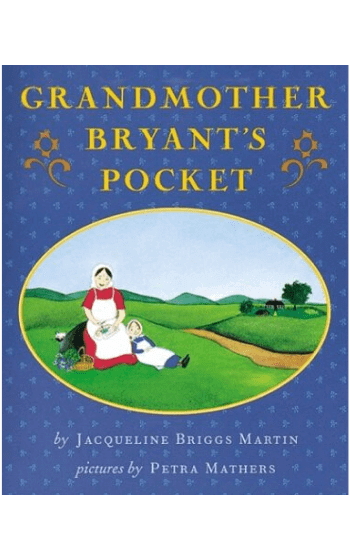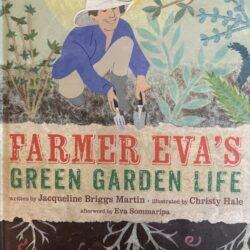
- Publisher: Houghton Mifflin
- ISBN: 978-0-395-68984-4
- Published: January 1, 1996
Illustrated by Petra Mathers
Houghton Mifflin, 1996
Find @ Your Public Library
About the Book
Grandmother Bryant’s Pocket is a story about Sarah Bryant, an eight-year-old girl who lived two hundred years ago on a farm in Maine. When the barn burns down and Sarah’s dog Patches is caught in the fire she begins to have bad dreams. Nothing her parents do helps Sarah get over these nightmares. So she goes to live with her Grandmother and Grandfather Bryant. Grandmother Bryant is a healer and Grandfather Bryant a whittler.
Two hundred years ago pockets were not sewn into women’s clothes but were tied around the waist under a skirt, a bit like our own “fanny packs” would be if we wore them under our clothes. Grandmother Bryant’s old pocket with its stitches and smells, Grandfather Bryant’s stories, and a one-eyed cat eventually help Sarah get over her nightmares and even face the biting, pinching geese which had terrified her.
Awards
Grandmother Bryant’s Pocket won Maine’s Lupine Book Award.
Grandmother Bryant’s Pocket was declared:
- A Bulletin Blue Ribbon book
- A School Library Journal Best Book
- An ALA Notable Book
- A Hungry Mind Review Book of Distinction.
Curriculum
Make pockets as Sarah had in Grandmother Bryant’s Pocket.
Healing Herbs/Plants — Two hundred years ago healers could not go to the drug store for medicines but depended on various plants to help people recover from burns, cuts, or other sickness. Some of the plants they used are plants we can find growing in our own yard.
- A good example is the dandelion. You might see dandelions in your yard or neighborhood. Their seeds were brought to this country by some of the first immigrants so they could have fresh greens in the spring. (Some people still use dandelion greens as a salad green. They must be picked before they blossom — be careful not to pick if they have been sprayed with a herbicide — washed and served fresh.)Dandelions have spread all over the United States. Some people think their leaves and flowers are quite beautiful. The leaves of the dandelion can be dried and used as part of a picture collage.
- Wild mint was used in tea, and bathwater. You can often tell a mint plant by its smell. All members of the mint family have square stems. You can dry mint as Sarah and her grandmother did. (Before you pick any plant have an adult help you identify it.)
Other important healing plants can be found in our kitchens.
- Onions were a favorite cure for chest colds. They were chopped up, fried, and wrapped in a cloth that was then placed on the chest. We now know that onions are a very healthy food. So perhaps the “chopped onion cure” was a good one.
Games to Play and Things to Do:
You might play — or have played — some of the same games that Sarah Bryant and her cousins would have played, games such as “London Bridge is Falling Down,” or “Here We Go Round the Mulberry Bush,” or “Ring Around a Rosy.” Find a book that gives directions for playing these games.
Try some of the activities that children in Sarah’s time liked to do:
- Children in Sarah’s time also liked to go ice-skating and sledding in the winter.
- They collected glass marbles and played marbles in the spring.
- In the summer girls picked hollyhock blossoms and turned them upside down to be ball gowns for dolls.
- They made doll furniture from sticks, milkweed pods and other things they found.
- Sarah’s cousin Thomas might have had a small knife that he used to whittle whistles from chestnut or willow trees.
- Children of all ages were expected to work.
- Boys whittled brooms and girls were taught to knit as soon as their hands could hold the needles.
- Often they were the ones to go through the wool sheared from the sheep and take out the straw and twigs.
- There were no cameras in Sarah’s day. But people did draw silhouettes, outlines of a shape, like a shadow would make, and cut them out of black paper.
Reviews
Though its story is set in 1787, this pocket-sized book tells a timeless tale about fears and their healing. … The story unfolds in miniature chapters, brightened by Petra Mathers’ charming and expressive illustrations.
— Hungry Mind Review (Summer 1997, pg. 28)
Set in 1787, this inspiring story tells of a girl’s grief at the loss of her dog, and the gradual healing process she undergoes. Eight-year-old Sarah Bryant is racked by nightmares after her beloved Patches dies in a fire, and so her parents send her to stay with her grandparents. … A pleasingly timeless historical tale. Ages 5-9. (Mar.)
— Publishers Weekly (March 1996)
Kindergarten-Grade 4-A story set in Maine in 1787. Eight-year-old Sarah Bryant has been plagued by nightmares since the family barn burned down and her beloved dog died in the fire…. Martin’s straightforward narrative can be enjoyed as a read-aloud or by independent readers. The pocket-size dimensions of the book fit the story and its potential readers well.
The text is divided into small sections with headings, making it a pre-chapter book. Delightful, bright watercolor illustrations in a folk-art style show many interesting details about farm life at the end of the 18th century. An illustrated appendix describes the herbs mentioned in the text and their uses.
— School Library Journal
Gr. 2-4. There is a quaint warmth to this story set in rural Maine in 1787. … Sarah slowly overcomes her grief and fear. When Grandmother Bryant needs a remedy for a wounded neighbor, Sarah bravely fetches it despite a flock of hissing geese.
Appealingly structured in one-and two-page chapters, the book is illustrated with watercolor paintings. Executed in naive style, the artwork has an unassuming sweetness. Some vocabulary is likely to be unfamiliar to young readers, but a brief, illustrated glossary of herbs is appended.
— Booklist
…In time Sarah is helped over her nightmares by a one-eyed cat who comes to sleep on her pillow and, indirectly, by a greedy neighbor who finds Sara’s lost pocket and connives to keep it. Martin gives the story, which is set in 1787, a distinctive tone in poetic chapters that are seldom more than a page long.
Aphorisms and folk wisdom intertwine with the telling; characterizations are revealed in two or three unforgettable lines (“Beck Chadwick would walk uphill to make trouble” and “would rather spread bad words that eat apples”). Mathers’s cameo-like illustrations harmonize beautifully with the story; its theme resonates. (Fiction. 5-9)
— Kirkus Reviews

